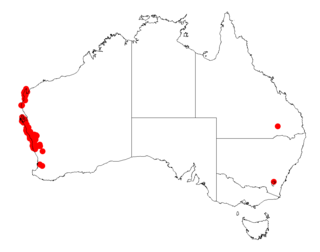Acacia anastomosa, also known as Carson River wattle, is a shrub belonging to the genus Acacia and the subgenus Juliflorae that is endemic to north western Australia.

Acacia drepanocarpa is a shrub belonging to the genus Acacia and the subgenus Juliflorae native to northern Australia.

Acacia laccata is a shrub belonging to the genus Acacia and the subgenus Juliflorae that is endemic to northern Australia.

Acacia levata is a shrub belonging to the genus Acacia and the subgenus Juliflorae that is endemic to small arid area of western Australia.

Acacia limbata is a shrub belonging to the genus Acacia and the subgenus Juliflorae that is endemic across northern Australia.

Acacia oldfieldii is a shrub belonging to the genus Acacia and the subgenus Juliflorae that is endemic to western Australia.

Acacia oncinophylla, commonly known as hook-leaved acacia, is a shrub belonging to the genus Acacia and the subgenus Juliflorae.

Acacia orthocarpa, also commonly known as Pilbara weeping wattle, needle-leaf wattle or straight-podded wattle, is a shrub or tree belonging to the genus Acacia and the subgenus Juliflorae that is endemic to tropical parts of northern Australia. The indigenous Nyangumarta peoples know it as yartupu.

Acacia ptychophylla is a shrub belonging to the genus Acacia and the subgenus Juliflorae the is endemic to arid areas of north western Australia.

Acacia stigmatophylla, also known as djulurd, is a shrub belonging to the genus Acacia and the subgenus Juliflorae the is endemic to northern parts of Western Australia.

Acacia wickhamii is a shrub belonging to the genus Acacia and the subgenus Juliflorae that is endemic to parts of northern Australia.

Acacia spathulifolia commonly known as Gold carpet or the Gold carpet wattle is a shrub of the genus Acacia and the subgenus Phyllodineae that is endemic to coastal parts of western Australia.

Acacia warramaba is a shrub of the genus Acacia and the subgenus Plurinerves that is endemic to an area of south western Australia.

Acacia falciformis, also commonly known as broad-leaved hickory, hickory wattle, mountain hickory, large-leaf wattle, tanning wattle and black wattle, is a shrub belonging to the genus Acacia and the subgenus Phyllodineae that is endemic to eastern Australia

Acacia obtusata, commonly known as blunt-leaf wattle or obtuse wattle, is a tree or shrub belonging to the genus Acacia and the subgenus Phyllodineae native to eastern Australia.

Acacia nana, also known as the small red-leaved wattle, is a shrub belonging to the genus Acacia and the subgenus Phyllodineae where it is endemic to eastern Australia.

Acacia calyculata is a shrub belonging to the genus Acacia and the subgenus Juliflorae that is native to north eastern Australia.

Acacia cataractae is a shrub belonging to the genus Acacia and the subgenus Juliflorae that is native to northern Australia.

Acacia praetermissa is a species of wattle native to a small area in the Northern Territory of Australia. It was listed as vulnerable in 2006 according to the Environment Protection and Biodiversity Conservation Act 1999.

Acacia williamsiana is a tree or shrub belonging to the genus Acacia and the subgenus Juliflorae that is native to eastern Australia.



















